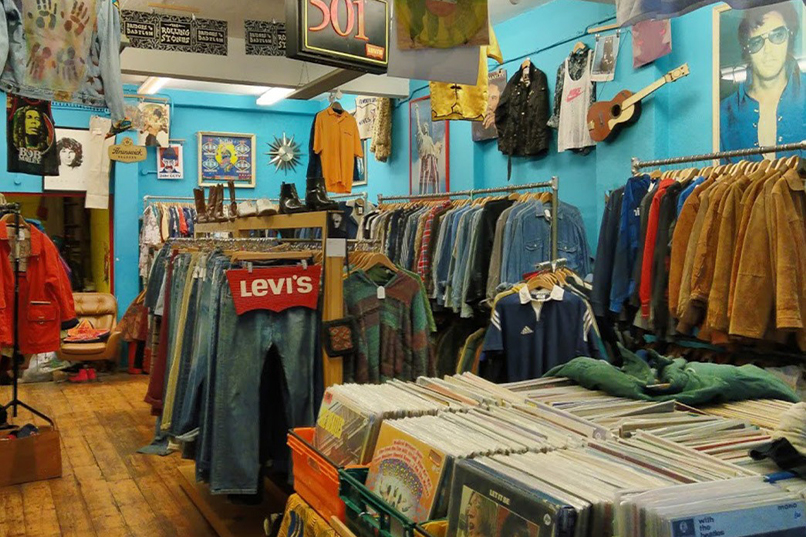Shopping for vintage is an exciting and rewarding experience. Vintage clothing and accessories not only offer a unique and individual style but also a glimpse into the past. Vintage pieces often have a story to tell and are of exceptional quality, making them a sustainable and environmentally conscious choice. However, shopping for vintage can be daunting, especially if you are new to it. Here are some tips to help you shop for vintage like a pro.
Do your research
Before you start shopping for vintage, it is important to do your research. Get familiar with the different eras and styles, and learn about the designers and brands. This will help you identify authentic pieces and make informed decisions. The internet is an excellent resource, but there are also many books and magazines dedicated to vintage fashion that can be a valuable source of information.

Check the condition
Vintage pieces are often pre-owned, and their condition can vary. When shopping for vintage, always inspect the item carefully for any signs of wear and tear, such as stains, holes, or loose threads. Some minor flaws can be repaired, but others may be irreparable. Also, check for any signs of aging, such as discoloration or fading.
Try it on
Vintage sizing can be very different from modern sizing, so it is essential to try the item on before buying it. Don’t rely on the size tag alone. Take your measurements and compare them to the garment’s measurements. Remember that vintage pieces were often tailored to fit a specific body shape, so they may not be as forgiving as modern clothing.
Look for quality
One of the advantages of shopping for vintage is that you can find pieces that are made of high-quality materials and craftsmanship. Look for natural fabrics such as silk, wool, and cotton, and check the seams, buttons, and zippers for any signs of wear. Vintage pieces that have stood the test of time are more likely to continue to do so.
Shop in person
While shopping for vintage online can be convenient, it is not always the best option. Shopping in person allows you to inspect the item thoroughly, try it on, and get a feel for the quality and condition. You can also ask the seller questions about the item’s history and provenance, which can add to its value and interest.
Have an open mind
Vintage shopping is all about discovery and creativity. Don’t limit yourself to a specific style or era. Be open to exploring different styles and mixing vintage pieces with modern ones. Remember that vintage fashion is not just about trends, but also about individuality and self-expression.

Consider the price
Vintage pieces can range from affordable to very expensive, depending on their rarity, condition, and demand. Set a budget before you start shopping and stick to it. Remember that vintage pieces are often one-of-a-kind and can be hard to find again, so it’s okay to splurge on something you love. However, don’t forget that vintage fashion should also be a sustainable and responsible choice.
Check out vintage shops
Vintage shops are a great place to start when you’re looking for vintage pieces. They offer a curated selection of clothing and accessories, and the staff is often knowledgeable and helpful. Vintage shops also tend to specialize in certain eras or styles, so you can find exactly what you’re looking for.
Go to vintage fairs
Vintage fairs are a great place to find unique and rare pieces. They bring together multiple vendors in one place, and you can often find pieces from different eras and styles. Vintage fairs also offer a fun and social experience, with music and food stalls adding to the atmosphere.
Explore flea markets and thrift stores
Flea markets and thrift stores are a treasure trove of vintage pieces, and you never know what you might find. The prices are often lower than in vintage shops or fairs, and you can find pieces that have not been curated or restored. However, be prepared to spend some time and dig through the racks to find hidden gems.
Look for signs of authenticity
Authenticity is crucial when shopping for vintage pieces. You want to make sure that what you’re buying is genuine and not a reproduction or fake. Look for labels, tags, and other signs of authenticity, such as hand-stitching or fabric quality. Also, research the era and style of the piece to make sure that it matches the item’s characteristics.
Ask questions
Don’t be afraid to ask questions when shopping for vintage pieces. Ask the seller about the item’s history, provenance, and condition. If you’re buying from a vintage shop, ask about their selection process and if they restore or repair the pieces. Asking questions can also help you negotiate the price or find out if there are any discounts or deals available.

Mix and match
Vintage pieces can be a great addition to your wardrobe, but they don’t have to be worn head to toe. Mixing vintage and modern pieces can create a unique and stylish look. Pair a vintage blouse with a modern skirt or jeans, or wear a vintage jacket with a simple t-shirt and sneakers.
Consider alterations
Sometimes, vintage pieces may not fit perfectly or may have some flaws that can be repaired. Consider getting the piece altered or repaired by a professional tailor or seamstress. They can adjust the size, hem length, or replace buttons and zippers to make the piece more wearable.
Enjoy the process
Shopping for vintage should be a fun and enjoyable experience. Take your time, enjoy the hunt, and don’t get discouraged if you don’t find what you’re looking for right away. Vintage pieces are often one-of-a-kind, and finding the perfect piece takes patience and persistence.
In conclusion, shopping for vintage can be a thrilling and rewarding experience, but it can also be overwhelming. By exploring different venues, checking for authenticity, asking questions, mixing and matching, considering alterations, and enjoying the process, you can find the best vintage pieces that reflect your individual style and personality.







